Business Practices & Ethics
What we do and why we do it.
(Who cares? is not an unreasonable response)
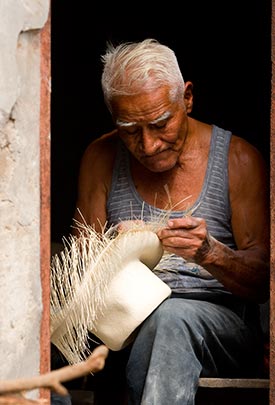
Why the Business Exists—The business was created in 1988 with the specific goal to prevent the impending extinction of the art of fine hat weaving in Montecristi.
Weavers, artisans, dealers, all told me that hat weaving was diminishing year by year. In 1986, author Tom Miller (The Panama Hat Trail) predicted the demise of fine hat weaving within twenty years.
I read the book, went to Montecristi, and fell in love with the hats. I figured that if people weren’t weaving as many hats as they used to, it was because people weren’t buying as many hats as they used to. If people would show up with stacks of money to buy hats, other people would show up with stacks of hats to exchange for the money. Simple. To save the art, I must buy lots of hats to increase the demand. If I buy lots of hats, I must also sell lots of hats. Hence, the business.
Hat Buying
Money Talks—How do we save the art of fine hat weaving? Simple. Buy as many hats as possible. Increased demand should result in increased supply.
If we want there to be hat weavers in ten years, then hat weavers now must earn more from weaving hats than they can earn by taking a different job. One hundred years ago, even fifty years ago, there simply were not any other ways to earn a living. Now there are.
Hat weavers must earn enough to enjoy a reasonable quality of life. Otherwise, no one will choose to be a hat weaver, now that there are jillions of other occupations to choose from.
Buying from Dealers—For the first fifteen years, I purchased hats only from the established dealers in Montecristi. I worked within the existing system. I learned that the existing system is the continuation of a century-old feudal mercantile system with weavers at the very bottom. The system was built upon the previous reality that weavers had no options, no other way to earn a living, so buyers made all the rules.
Even today, the person who buys a hat from the weaver—and drives it to Montecristi to sell to one of the dealers there—often earns more than the weaver! There was no established grading system, no apparent pricing system. There was a very loose correlation between price and quality.
A weaver did not necessarily earn more for a hat with 24 rows/inch than for one with 18 rows/inch. Year after year, the dealers refused to pay extra dollars for extra work, or for better work. Eventually, the weavers virtually stopped weaving larger size hats and hats with wide brims. The weavers learned to weave the least fine hats they could while still receiving the same pay. They wove slightly shorter hats. They favored small head sizes. They tried to weave faster, making more mistakes. They simply defended themselves as best they could against abusive market practices. You and I would do the same.
Year after year, I tried to persuade the dealers I worked with to change their business practices, to pay the weavers more. I stipulated I would pay more. I learned that paying more to the dealers was not the same as paying more to the weavers. To pay the weavers more, I must pay the weavers directly.
Understand that the dealers were not wealthy hat lords lighting cigars with hundred-dollar bills. But they did achieve an enviable middle class lifestyle out of reach of the weavers, and part of the methodology was to pay as little as possible and fairness be damned. They did not seem to see the bigger picture: they were putting themselves out of business by forcing weavers to look for other work. No weavers, no hats. No hats, no business.
Buying Directly from Weavers—When possible, I now buy directly from the weavers. To do that effectively, I became we. I now have two partners in Montecristi, Jorge and Diego, who are making good things happen. (Diego is now a contract fireman for a U.S. military base in Djibouti, but he will be back to help again.)
When we buy directly from weavers, we can be certain weavers actually receive the pay increases we believe are necessary to the survival of the art. And when we offer higher prices, other buyers are forced to offer higher prices also, to prevent us from just buying all the hats. As intended, the weavers are the primary beneficiaries of this change. My buying practices are more popular with weavers than with other buyers.
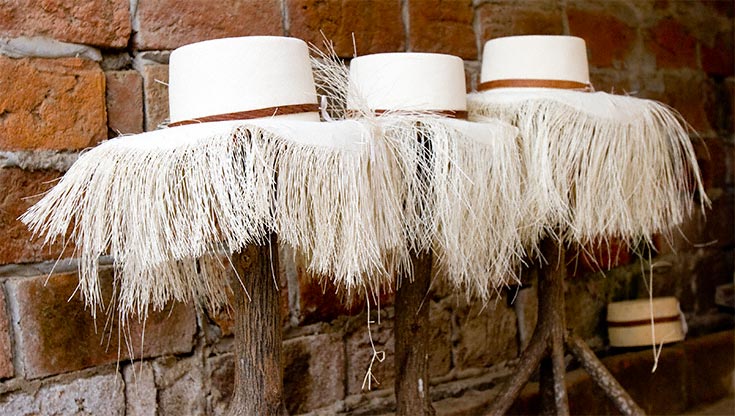
My accountant doesn’t understand my buying practices either. He never heard of a business trying to force up the prices it pays for its supply. Simple: by increasing prices now, I am trying to increase the likelihood that I (and the rest of the world) will still have a supply five years from now, ten years from now.
Pay More, Pay Extra—We pay weavers more than other buyers pay. We pay Montecristi artisans more than others pay. We pay the weavers extra for hats that are larger sizes, have wider brims, or both. We pay extra for finer hats, for better hats. If we want the weavers to work more hours, we pay them more dollars. The same with the artisans who finish the hats.
Organized System of Buying Prices—We decide how much to pay for a hat after we:
- count the weave,
- decide if the rows are straight and even,
- make sure there are no problems with the straw color, holes, damage, etc.
We also measure the size of the hat, the crown height, the brim width. All of these factors are considered when determining a price for the hat.
We use the same system for everyone. Sometimes we pay more than the weavers ask. (see related story) Sometimes we do not buy. We explain our prices and our reasons. No mysteries, no games, no gotcha. We do not try to get the best of them. They are not our adversaries; they are our heroes. In business terms: without them there is no business. For us to survive, they must survive. For us to flourish, they must flourish.
We want the weavers to understand the value of their hats, what makes one hat worth more than another, how to weave hats that will bring higher prices. We believe weavers will weave better hats if they understand exactly what “better” means, and exactly how much more it pays.
Unprecedented Sales Commissions for Weavers—We represent the very best weavers much like an art gallery represents painters. Even better. First, we pay the weavers higher-than-market prices to purchase their hats. Then, when the hats are sold, the weavers and other artisans also receive bonuses/commissions up to 40% of the sale price. One weaver has already received a check for one hat that was equal to what he used to earn in an entire year. A second weaver received a check for more than what he used to earn in two years.
Simón Espinal is now the highest paid weaver in history, just based on his base pay, before adding in his commissions.
Hey! I want some of that—We want weavers of the very finest hats to earn more than any weavers have ever earned. We want their standard of living to increase visibly. Weave better, live better.
If fine weaving is well rewarded, many will aspire to become fine weavers. When a kid from the inner city gets a big NBA contract, the playground hoops become more crowded. I’m trying to do something similar with hat weaving.
Discoverers of the Obvious—We simply do what seems to us to be obvious. Be fair. Extra pay for extra work. Better pay for better work. The very best artists must live well enough to inspire others to want to be the best. Montecristi hats should have a grading system so buyers and sellers can both understand and use the same system.
Supplies for Weavers
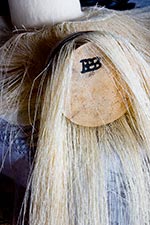 Forms for Weavers—Large size hats were no longer being woven. Weavers no longer
even had wooden weaving forms in large sizes. In May 2006, we provided 70 free forms to weavers in
Pile and Las Pampas. Mainly large sizes that no one had. Now weavers can fill the demand for large
size hats. We do not place any restrictions on the use of our forms. The weavers may weave hats that
they sell to someone else. We will do this as often as the special type of wood can be found, cured,
and shaped. We pay more for larger size hats woven on these forms. We have more cured wood now, and
more forms are being made.
Forms for Weavers—Large size hats were no longer being woven. Weavers no longer
even had wooden weaving forms in large sizes. In May 2006, we provided 70 free forms to weavers in
Pile and Las Pampas. Mainly large sizes that no one had. Now weavers can fill the demand for large
size hats. We do not place any restrictions on the use of our forms. The weavers may weave hats that
they sell to someone else. We will do this as often as the special type of wood can be found, cured,
and shaped. We pay more for larger size hats woven on these forms. We have more cured wood now, and
more forms are being made.
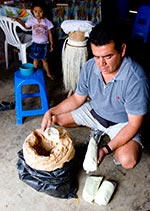 Free Sulfur—The weavers have a constant need for sulfur powder. The
tallos
of soon-to-be straw, the prepared straw, and the hats are all smoked with burning sulfur to kill off
any fungus that might turn the straw black. We now provide, free of charge, two types of sulfur
powder to the weavers of Pile. Pure sulfur and a weaker, diluted powder that is part sulfur and part
other stuff. Each type works for a different purpose, a different phase of production. This program
is working very well and is extremely popular.
Free Sulfur—The weavers have a constant need for sulfur powder. The
tallos
of soon-to-be straw, the prepared straw, and the hats are all smoked with burning sulfur to kill off
any fungus that might turn the straw black. We now provide, free of charge, two types of sulfur
powder to the weavers of Pile. Pure sulfur and a weaker, diluted powder that is part sulfur and part
other stuff. Each type works for a different purpose, a different phase of production. This program
is working very well and is extremely popular.
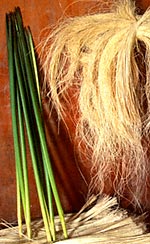 Free Straw?
We are trying to find a good straw maker we can pay to harvest
cogollos
and prepare straw for weavers. For weavers who now prepare their own straw, this will leave them
more time to weave. Preparing the straw is a time-consuming process.¹,
²
For those weavers who purchase straw already prepared, we will save them the cost of the straw and
leave them with more money for food and clothing. We are still in the beginning stages of this
project.
Free Straw?
We are trying to find a good straw maker we can pay to harvest
cogollos
and prepare straw for weavers. For weavers who now prepare their own straw, this will leave them
more time to weave. Preparing the straw is a time-consuming process.¹,
²
For those weavers who purchase straw already prepared, we will save them the cost of the straw and
leave them with more money for food and clothing. We are still in the beginning stages of this
project.
More Than Hats
Man does not live by hats alone. We also do more than do business.
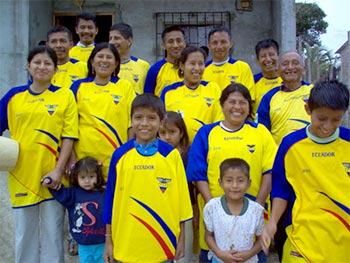
Soccer Jerseys—When Ecuador made its first-ever appearance in the World Cup, we bought Ecuador soccer jerseys for twenty of the best weavers. They loved them.
Sponsor of the Pile Soccer Team—We pay for the uniforms and equipment of the Pile soccer team. I asked to name the team. I named them the Pile Superfinos. Works for the hats, and no one would object to being called a super-fine person.
I let them choose their own uniforms of course. But in my fantasies, I imagine designing new uniforms that are serious Superfly fashion statements, truly super-fine uniforms. I also imagine the team taking the field with some kind of rhythmic chant, like the football team in Remember the Titans (the screenwriter of Titans is a client). Super fine.
My one problem with the soccer team is that Simón is the goalie. The best weaving hands in the world are in harm’s way every time someone kicks a ball at the Superfinos’ goal. I freaked. I immediately went out and bought the best goalie gloves I could find and gave them to Simón. I hope he wears them.
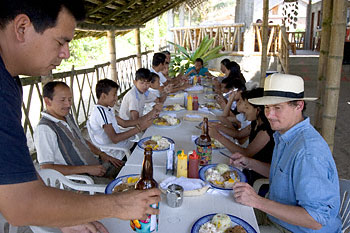
Thanksgiving Dinner—We once sponsored a Thanksgiving dinner for weavers and their families at Jorge’s hotel restaurant. The food was delicious. Everyone had a special day. For the kids, the hotel swimming pool was an even bigger treat than the meal. They had never ever been in a swimming pool. And it wasn’t just a big deal for the kids. Simón’s mother was so enthralled by the swimming pool that she stripped down to her bra and panties and got in the pool herself.
Par-ty! Par-ty! Par-ty!—Many years ago, after my first visit to Pile, the Delgados told me that there had never been a fiesta in Pile. No parties? Not ever? Didn’t seem right. So the hat company sponsored the first-ever Pile Fiesta Day. We brought in a big meal and fed 500 people. We also brought in a disco-mobile and got them all dancing and partying. Hard to say who had more fun—them doing or me watching.
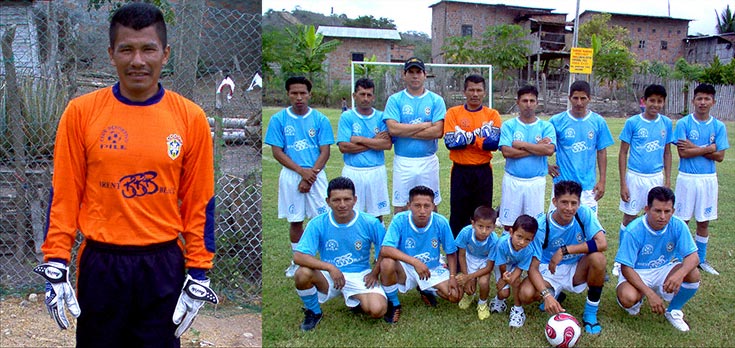
The Superfinos—We sponsor Pile’s soccer team. Simón, the best weaver in the world, is its goalie. Be sure to wear those gloves, Simón!
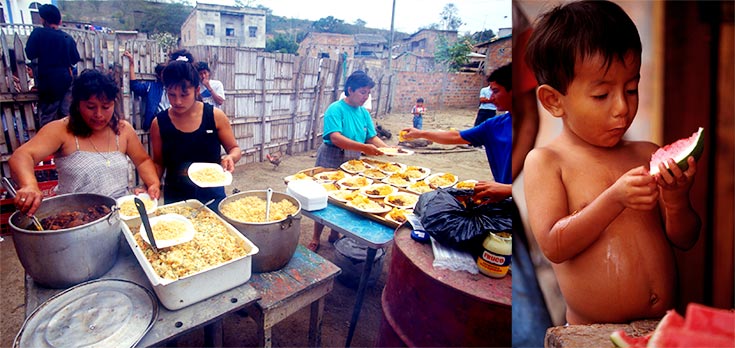
Free Food Staples—Back in my early days, before the foundation, I also funded a project to provide food staples for the weavers. Rice, sugar, cooking oil. Good project, never enough money.
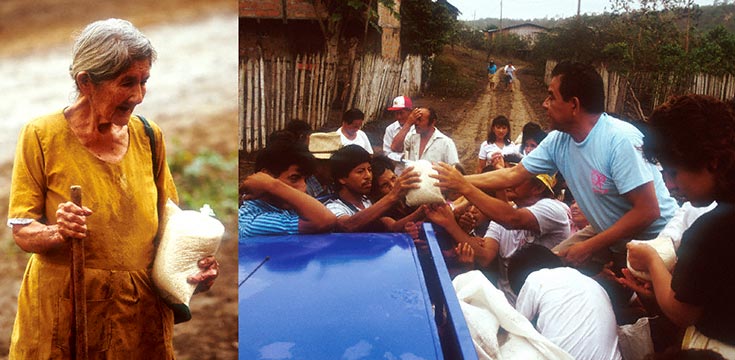
I’m doing my best to do my best to save this art.
Growing the Global Market
In order to save the art of fine hat weaving, weavers and artisans must earn better pay (or soon there will be no weavers and artisans), and global demand for Montecristi hats must increase. As prices paid to weavers and artisans increase, retail prices will also increase. For consumers to want to buy Montecristi hats, and to be willing to pay fair (i.e. high) prices for them, they must understand why the hats are desirable and well worth the prices.
On the supply side, we are raising wages for weavers and artisans, providing free forms and sulfur to reduce their expenses, establishing fair buying practices, paying extraordinary commissions for extraordinary hats, trying to find a way to protect the land and the plants that supply the straw, and on and on.
On the market side, our goals are:
- To raise overall awareness of Montecristi hats,
- To increase consumer desire to own and wear Montecristi hats,
- To offer Montecristi hats for sale to fill as much of the demand as possible.
The colorful history of these legendary hats is very interesting to most people. The complex and difficult process of preparing the straw, weaving and finishing the hats, then blocking and styling them has also proven to be interesting enough to engage readers and listeners. The more that people know and understand about Montecristi hats, the more likely they will be to want one. We must get the information out into the market, spread the word.
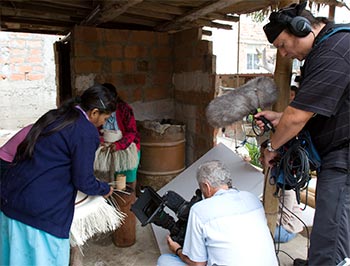
Working with the Media—We make every effort to encourage media coverage of Montecristi hats. We provide hi-resolution photo images at no charge on request. We have provided photos for magazines literally all around the world. We are happy to provide whatever general and specific information is requested, and even help write the piece if it will help. (see media coverage) The more media coverage, the more awareness. The more awareness, the more demand. The more demand, the more sales—for everyone who sells Montecristi hats, not just for us.
World’s Most Extensive Reference Library—The Photo Tour on this web site presents, in text and photos, the most complete, most detailed documentation of the process of making Montecristi hats that can be found anywhere, online or off. The site also provides extensive information about “grading” and pricing Montecristi hats, how to determine your proper size, Panama hats in the movies, famous people who have worn Panama hats, and on and on. We know that shoppers sometimes read everything on the site then make a purchase elsewhere. Every Panama hat sale helps to save the art, no matter who makes the sale. We are delighted to be able to help grow the total market. Naturally, we hope most of you will choose to buy your Montecristi Panama hats from us. And judging by how busy it is around here, even in the “off” season, most of you do. Thank you.
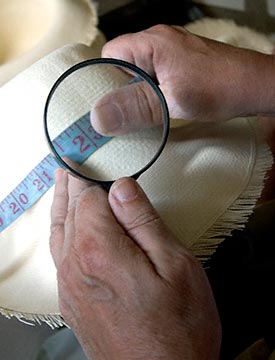
New Montecristi Hat Grading System—In 2002 we published on this web site a new grading system for Montecristi Panama hats, beginning with a formula for counting the fineness of the weave: the Montecristi Cuenta. The Montecristi Cuenta weave count has become the industry and Internet standard for comparing Montecristi Panama hats. We soon will expand the system to include measurements/indicators of Weave Quality and Straw Color.
When you are buying a diamond, the four factors that determine the price are Carats, Clarity, Color, Cut. The four factors one would use to “grade” a Montecristi hat are: Weave Fineness (how many rows of weave per inch), Weave Quality (how straight and even are the rows), Straw Color, Blocking. The “4 C’s” are a lot easier to remember than this hat grading system. FQSB isn’t very catchy, is it? Suggestions welcome.
Text and photos © 1988-2022, B. Brent Black. All rights reserved.
100% Secure Shopping









































